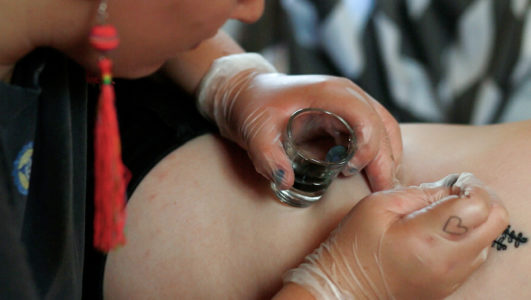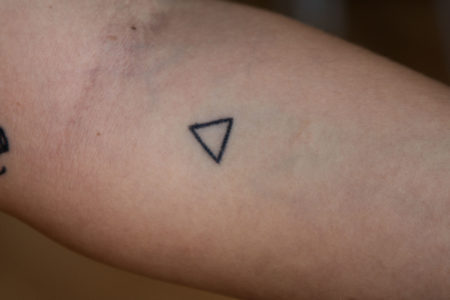“How much is this gonna hurt?” asked Manan Pradhan ’20 before Madeleine Brand-LaBarge ’18 began tattooing the words “Gimme Shelter” on his arm, his first tattoo.
“People wouldn’t do it if it was unbearable. But you will go numb at a certain point,” Brand-LaBarge said. “You’ll feel the pain, and as fast as you realize it, it’s gone.”
Brand-LaBarge has made a name for herself on campus as a stick-andpoke tattoo artist. She grew up doing art, starting in kindergarten with macaroni and glue, then onto high school and college with charcoal drawings and now, stick-and-poke tattoos.
“The need arose for me to give myself tattoos for cheap. I have studio tattoos that I started getting when I was 19, but then I wanted little things and most studios have a minimum price of 50 dollars and I almost never have 50 dollars handy for me to spend on just getting a tattoo,” she said.
When she began sticking and poking, she used sewing needles, which are much thicker than tattoo needles. She only used sewing needles on herself, until she perfected her craft and her materials enough to start tattooing friends. She uses double-sterilized needles and India ink, advising her friends on how to take care of their tattoos afterwards.

“Aftercare for hand poke tattoos is basically the same as studio tattoos. Just wash them in the shower (or once a day) with antibacterial soap — I use Dial — and then after put a no frills lotion on, like Cetaphil or Lubriderm, and that keeps it clean and healing,” she wrote in an email to The S&B.
Her recent stick-and-poke designs include flowers, words, a cactus and a construction crane, based on Grinnell’s very own campus crane.
“That was the most geometrically complex that I’ve done,” Brand-LaBarge said. “I really did love doing the crane because it was a funny Grinnell thing to do.”
Although Brand-LaBarge enjoys designing her tattoos herself, she also enjoys when other people bring her designs they want done on themselves.
“Stick-and-poke as a type of tattoo and not professional machine tattoos, you get silly doodle things you wouldn’t go to a studio for, and that’s what I’m doing. People come to me with things they want and because I feel confident in my ability to copy drawings that people give me, I can make it happen for them without having to pay a studio to do it,” she said.
Before beginning a tattoo, she discusses the design with the friend whose body it’s being permanently drawn onto. She draws it in a sketchbook, then on their body and then she finally begins the stick and poking process.
“See? It’s not that bad. It’s quick pain. You won’t notice it as much. I think it’s more annoying than painful,” Brand-LaBarge said to Pradhan.
“It’s definitely more annoying than painful. Oh, that last one kind of stung,” Pradhan retorted.

After the initial line of dots, Brand-LaBarge has to go over the tattoo again and again, making sure that the line is thick, even and without gaps. She goes over each tattoo so many times that she loses count.
“I think that is an answer in itself,” she said. “If you think about trying to make a solid line with a tiny needle, you’re gonna have to go over it, fill it in, fill in gaps, so I stop when I feel like it looks like a solid line.”
The preciseness of the stick-andpoke is what differentiates it from other types of art Brand-LaBarge has undertaken, like charcoal drawings.
“At the base of it, charcoal drawing you’re not creating something by single dots, and that’s why stick and pokes are a lot more focused — I have to put together thousands of tiny little needlepoint sized dots to make something. With charcoal it’s strokes of this, shading of this, and tattooing is a lot more … focus on every single point that I make, especially because it’s permanent, and with charcoaling there’s a certain margin of error you can make, erase and smudge, but that is absolutely not the case with tattooing,” she said.
She finds that giving herself tattoos is much more relaxing than giving them to her friends because she trusts herself to fix any mistakes she might make.
“It’s completely different from the way I have to be thinking in my classes because I’m not thinking analytically, but I’m still incredibly focused and there’s an end goal, and it makes me feel very calm and zoned in for two hours,” she said. “I feel exhausted at the end, but it’s very rewarding.”

Photo by Helena Gruensteidl








































































